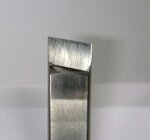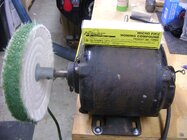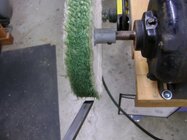I’ve always sharpened a skew free handed. The attachment looks like it would reduce grinding wear due to repeatable presentation of the skew to the wheel. It’s not expensive at $50 but is it worth it?
-
It's time to cast your vote in the October 2025 Turning Challenge. (click here for details) -
Congratulations to Curt Fuller for "Bell Ornaments" being selected as Turning of the Week for October 27, 2025 (click here for details) -
Welcome new registering member. Your username must be your real First and Last name (for example: John Doe). "Screen names" and "handles" are not allowed and your registration will be deleted if you don't use your real name. Also, do not use all caps nor all lower case.
You are using an out of date browser. It may not display this or other websites correctly.
You should upgrade or use an alternative browser.
You should upgrade or use an alternative browser.
Wolverine skew sharpening jig
- Thread starter Webb Willmott
- Start date
I have the wolverine skew jig. Tried it and and don't care for it even a little bit so it gathers dust. I thought I was using it wrong so I watched a Oneway video and disagreed with the way they sharpened. Come visit some and you can try it for yourself.
I sharpen nearly every skew by hand, held flat on the rest - perfect edge every time. I never slide the skew with the edge against the rest as I've seen some do - there's too much of a chance of it shifting a bit and putting several facets on the bevel. Instead, after setting the platform for the desired included angle, I get a repeatable edge with: set the platform angle, line up the skew angle by eye to set the skew angle, push the skew into the wheel, pull it back, move the skew over a bit and repeat. Flip the skew over and do the other side. I read a recommendation for this method once. Sharpening is very quick.
Could make a little guide to keep the skew angle constant but I'd need about 5 guides for my various skews but there is really no need. (For the other angle, the included angle, I make a platform-setting gages to set my preferred included angles, a couple shown here. These, plus a blue sharpie for testing, make skew sharpening life easy.)
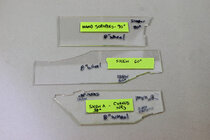
For a skew with a curved edge, I also sharpen by hand by pressing the flat of the skew tight against the rest and grind while pivoting. One or two passes on each side is usually enough.
The only skews I don't sharpen freehand using this method are the oval skews since they can easily roll on the tool rest. For that, I lock the skew into a Tormek skew jig which keeps the skew from rocking on the rest. That jig has a way to set the skew angle. (I use that jig on the Wolverine platform, not the Tormek.) This makes sharpening an oval skew easy.
A round skew can also roll on the rest but those I use are either 1/4" or 3/8" so they are relatively easy to grind.
BTW, I sharpen skews with 600 grit CBN, then strop the burr away on the Tormek leather stropping wheel. To refresh the edge after some use, I use my MDF boards described elsewhere. I used to use an extra fine (blue handled) EZE-Lap diamond paddle hone but have come to prefer the MDF method for skews. I want sharp, sharp, hair-shaving sharp.
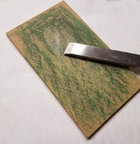
JKJ
I sharpen nearly every skew by hand, held flat on the rest - perfect edge every time. I never slide the skew with the edge against the rest as I've seen some do - there's too much of a chance of it shifting a bit and putting several facets on the bevel. Instead, after setting the platform for the desired included angle, I get a repeatable edge with: set the platform angle, line up the skew angle by eye to set the skew angle, push the skew into the wheel, pull it back, move the skew over a bit and repeat. Flip the skew over and do the other side. I read a recommendation for this method once. Sharpening is very quick.
Could make a little guide to keep the skew angle constant but I'd need about 5 guides for my various skews but there is really no need. (For the other angle, the included angle, I make a platform-setting gages to set my preferred included angles, a couple shown here. These, plus a blue sharpie for testing, make skew sharpening life easy.)

For a skew with a curved edge, I also sharpen by hand by pressing the flat of the skew tight against the rest and grind while pivoting. One or two passes on each side is usually enough.
The only skews I don't sharpen freehand using this method are the oval skews since they can easily roll on the tool rest. For that, I lock the skew into a Tormek skew jig which keeps the skew from rocking on the rest. That jig has a way to set the skew angle. (I use that jig on the Wolverine platform, not the Tormek.) This makes sharpening an oval skew easy.
A round skew can also roll on the rest but those I use are either 1/4" or 3/8" so they are relatively easy to grind.
BTW, I sharpen skews with 600 grit CBN, then strop the burr away on the Tormek leather stropping wheel. To refresh the edge after some use, I use my MDF boards described elsewhere. I used to use an extra fine (blue handled) EZE-Lap diamond paddle hone but have come to prefer the MDF method for skews. I want sharp, sharp, hair-shaving sharp.

JKJ
Last edited:
Not trying to be a smart alec, but how are you trying to sharpen today? I use a wolverine platform set to the desired angle using a Batty angle tool. Sharpening the straight skew across the wheel is an easier process than turning with the skew. There should be no issue with getting a consistent grind by hand with a skew. Jigs are wonderful things, but sometimes the best solution is a quick lesson and a bit of practice.
Roger Wiegand
Beta Tester
I bought the skew attachment when I first bought my Wolverine many years ago. Used it a couple times and then put it in a drawer. Haven't seen it or missed it for a decade now. I don't sharpen freehand though, I set the platform to the correct angle and use it to guide the sharpening. My preferred grind is the Lacer style curve with a bit of a squared off end at the long point. Since discovering Alan's nice teardrop diamond hone the only time the skew goes to the grinder is if I get a chip in the edge. That happened just last week, had to take off about 1.5 mm to get past it, but that was the first time in a couple years that I used the grinder on it.
I have been watching Richard Findley's videos on You Tube. Hope I spelled that right.... He does a lot of skew work. I feel that the skew needs to be stropped, he does not. It makes a noticeable difference to me. He also prefers to use a beading and parting tool for most of his beads. They do give me fits though.... I do sharpen on a platform, and never use a jig. Same for all of my turning tools....
robo hippy
robo hippy
As long as you don’t mind a hollow grind on the skew bevel, it works fine for me.
Similar to others, I purchased the jig when I first got into turning and after trying it once, never used it again. I just use a platform (robo-rest). I wouldn't bother with it if you already have a platform.
Similar to Roger, I like Alan Lacers partially curved shape for my larger (1") skew and then I have a 1/2" that is ground at a straight skewed angle. While I've seen many good turners use large skews exclusively, I still feel more comfortable using my 1/2" skew for smaller details/beads, etc.
Thanks,
Tom
Similar to Roger, I like Alan Lacers partially curved shape for my larger (1") skew and then I have a 1/2" that is ground at a straight skewed angle. While I've seen many good turners use large skews exclusively, I still feel more comfortable using my 1/2" skew for smaller details/beads, etc.
Thanks,
Tom
While I've seen many good turners use large skews exclusively, I still feel more comfortable using my 1/2" skew for smaller details/beads, etc.
Same here - 1/2" skew for most detail, large skew for large diameters (and beginners). I can't remember, I think I have about five 1/2", a 3/4", 1", 1.25" and 1.5". I have a piece of tool steel I was going to grind into a 2" skew but life got in the way.
I do keep one 1/2" skew sharpened a bit differently - it's a non-skewed skew, ground straight across. Perfect for removing wood quickly with peeling cuts.
I ground another "experimental" skew designed to be difficult or impossible to catch when making v-cuts. Story for another time.
JKJ
You not being a smarty. When I say freehand, I mean I don’t use a jig. I do use the grinder’s platform. Maybe not the correct definition but I hope we are on the same page.Not trying to be a smart alec, but how are you trying to sharpen today? I use a wolverine platform set to the desired angle using a Batty angle tool. Sharpening the straight skew across the wheel is an easier process than turning with the skew. There should be no issue with getting a consistent grind by hand with a skew. Jigs are wonderful things, but sometimes the best solution is a quick lesson and a bit of practice.
I find the skew one of the easiest tools to sharpen. My edges look good and I use a diamond hone periodically when turning.
The reason for asking is I recently got a gouge jig and it does better than I can using the platform. Which leads me to the question if a gouge attachment is a good thing, is a skew attachment a good thing.
After Roger’s response, I think I got my answer. I use a curve on my skew and don’t think the skew jig will work.
You guys are a wealth of information.
Like others I bought it early on and it hasn’t left the drawer in years
I have the skew attachment, and like many here, have used it a couple of times and gone back to the platform alone with a diamond hone and strop afterwards.
Tom Gall
TOTW Team
Greg, doesn't a cloth wheel like that round over the edge of your skew (microscopically)? That type of wheel is usually used to buff/shine metals - sort of like the Beall buffing wheels for wood finishes. Wouldn't a leather, hard felt or even a large MDF wheel work better?I use oneway platform and then stropping with buffing wheel for a scary sharp mirror edge.
I have never used the oneway jig for the skew.
I've used soft, flexible wheels in the past.Greg, doesn't a cloth wheel like that round over the edge of your skew (microscopically)? That type of wheel is usually used to buff/shine metals - sort of like the Beall buffing wheels for wood finishes. Wouldn't a leather, hard felt or even a large MDF wheel work better?
I find that hard, leather wheels are far better. (I've looked at the edges under my stereo microscope.) Even hard leather on a flat surface is good. I rub honing/polising compound into the surface of the leather.
JKJ
Add me to the list. The jig is somewhere gathering dust; haven’t seen it in quite some time.
- Joined
- Feb 28, 2021
- Messages
- 1,725
- Likes
- 1,537
- Location
- Roulette, PA
- Website
- www.reallyruralwoodworks.com
Likewise on the list - Jig sits gathering sawdust - seemed like a great idea at the time then I got a kodiak rest so I can now depend on my skew being exactly flat on the rest old rest let it wobble a little so bevel was a little wonky on each side... I pretty much have forgotten where it is (general idea in mind, but couldn't point it out exactly)
I used to use The wolverine platform but recently bought Stuart Baty's universal grinding platform. love it. as for the correct angle grind I use a piece of MDF cut to the angle I need. Just press it to the grinder (180g CBN) and rotate the UGP till it's flush. I can set up and sharpen in 60 seconds.
Sorry forgot to add : I use both-- original stropping is done on the Tormek T8 leather wheel and then touched up on the firm cloth wheel with the green metal polish , gets things razor sharp.Greg, doesn't a cloth wheel like that round over the edge of your skew (microscopically)? That type of wheel is usually used to buff/shine metals - sort of like the Beall buffing wheels for wood finishes. Wouldn't a leather, hard felt or even a large MDF wheel work better?
Heres Ernie Conover demonstrating on you tube.

